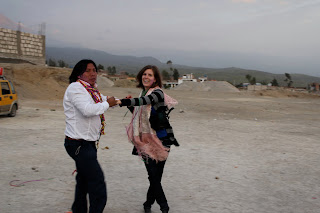Confused? I was, too, so I set out to see it in person. My first cortamonte took place at a soccer court in Andrea's neighborhood in Alto Cayma and was well underway when I arrived.
I wasn't ready to risk committing myself to being the host of the next year's cortamonte, but Andrea and Alex paired up and took their turns, first pouring chicha, the fermented corn drink, on the tree as an offering, then taking a swing or two at the tree before finishing up with a drink of chicha themselves and returning to the circle.
Andrea's first attempt:
(The woman in pink who offers her chicha was this year's host.)
Then Alex...
Then Alex...
Valiant efforts, but the tree still had a long way to go at this point.
One of the fascinating results of urbanization in Peru is the way people and their traditions adapt as they mix with groups from different regions in larger cities like Arequipa. Carnaval is a beautiful example of the hybrid celebrations that result: A blend of traditional dress (green skirt in the left of the photo is from Cuzco, and the other two are from Puno), music and dance from various regions, which are brought together in a strangely urban setting (a soccer court on the edge of town), to create a new kind of tradition.
It definitely becomes trickier to hold your host accountable the next year when it's not simply a member of your town, and many communities end up having to come up with a different host if they aren't able to track down their master of ceremonies. Still, it doesn't seem all bad when you see proud natives of the region whose music is playing teaching others how to move to the distinctive rhythms and then becoming students themselves for the next round of songs.
In this photo, the man to my right is dancing a traditional dance from Cusco, which Andrea and I tried to figure out without much luck,
while a woman in puneñan clothing works away on the tree in the middle of the circle.
I needn't have worried about finishing off the tree so early in the game, as it ended up taking another two hours before it went down. I think everyone was getting a little jealous of this napping baby..
But inevitably, the tree did go down and the boldest onlookers rushed to get their prize.
Andrea and I were quite proud of our mostly deflated balloon.
The next weekend's cortamonte was held nearby just below the workshop and church, but the presence of more Ñañas (pictured: Paulina, Augustina, Hilaria, me, Andrea, and Sebastiana)...
...a man in a gorilla costume armed with large supplies of pica pica (confetti) and purple talcum powder (Alex got the brunt of it here)...
... and some very enthusiastic dancers (new friend Inti pictured below) made for a memorable event.
Dancing continued long after the tree went down, first following it to the home of the next year's host, then back to Hilaria's, whose mother had hosted this year.
Final shot of the night: disheveled, tinted purple and covered in confetti, but sad to see Carnaval end. (I am still finding pica pica around my apartment.)












